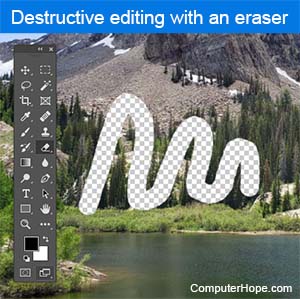Destructive editing

Destructive editing is a computer graphics term that refers to a permanent, irreversible change to an image. When you use a tool like an eraser, brush, or clone stamp in photo editing software, pixels are added, deleted, or changed. If you're using software with an undo command, you can temporarily reverse these changes in a certain time. When the image is saved in a format like PNG (portable network graphics) or JPEG (Joint Photographic Experts Group), however, you cannot undo a destructive edit.
When making destructive edits, we highly recommend saving a backup of the original image before you make any changes. For large or collaborative projects, nondestructive editing can allow for modification at any point during the process.
Examples of destructive editing
- Drawing new pixels on an existing layer with a brush.
- Deleting existing pixels using an eraser.
- Merging the contents of two layers.
- Adding highlights or shading using the dodge and burn tools.
- Smudging, blurring, or warping the contents of a layer.
- Adjusting brightness, contrast, white balance, levels, or curves without an adjustment layer.
As photo editing technology becomes more accessible, many destructive edits are becoming easier to reverse. However, we still recommend approaching these edits with caution to preserve the original details of the image.
